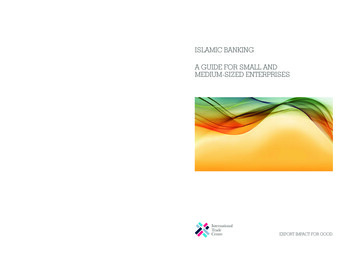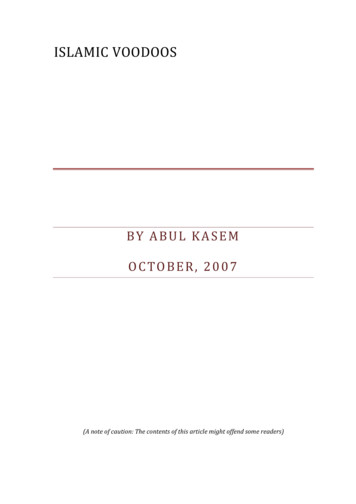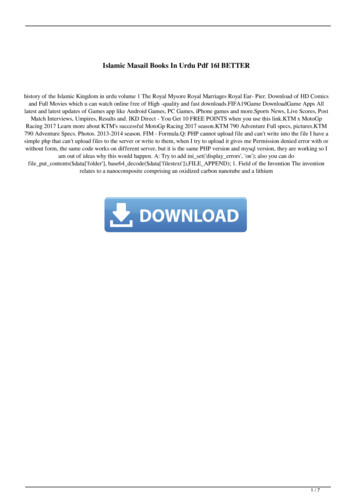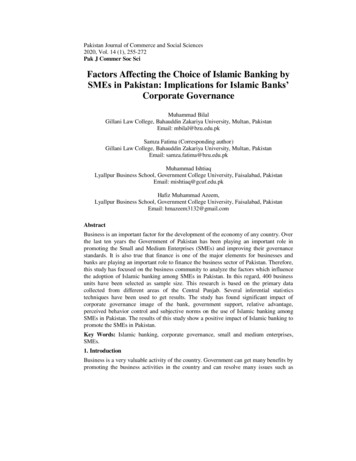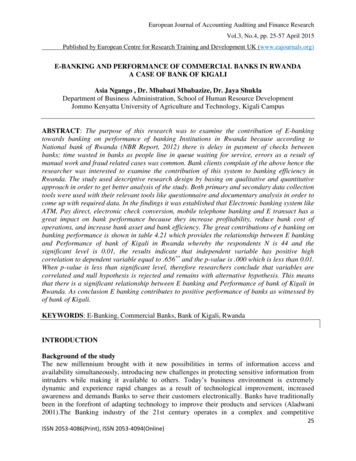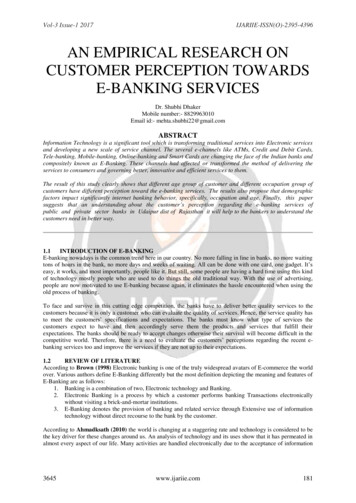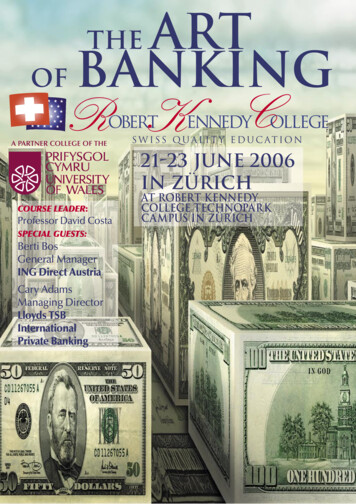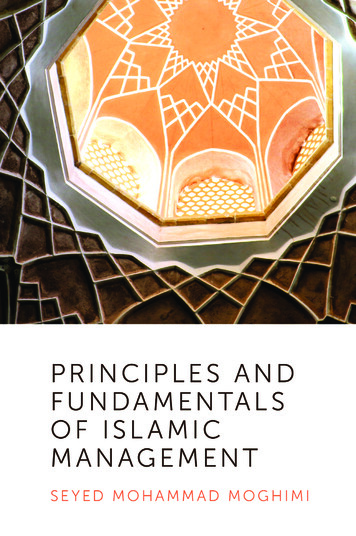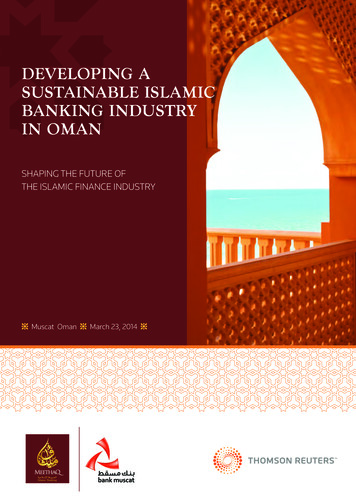
Transcription
Developing aSustainable IslamicBanking Industryin OmanShaping the Future ofthe Islamic Finance IndustryMuscat OmanMarch 23, 2014
COntentS4Highlights6Executive Summary10Recommendations12Session 1Surviving beyond the initial hype:Building sustainable Islamic banking businesses in acompetitive environment18Session 2Capturing the opportunity:Sukuk as a catalyst for foreign investment in Oman24Session 3Interactive session:Developing indigenous solutions for liquidity management for Oman’s Islamic finance industry
Highlights12341 Opening Remarks by Mr. Sulaiman Al Harthy, Group GM of Islamic Banking2 Presentation by Dr. Sayd Farook, Global Head IslamicCapital Markets, Thomson Reuters3 Opening Ceremony with Chief Guest HE Sheikh Abdullah Al Salim4 Islamic Finance Vision:Charting tomorrow’s path for sustainable growth in Islamic finance — Abdulhakeem Alkhayyat, Managing Director & CEO, Kuwait FinanceHouse Bahrain.4
Attendees by Job Position3%60%C NDEES BYJOB POSITION18%Finance16%OthersProfessionalsAttendees by Country3%Bahrain2%Others7%UAE88%Oman5
Executive SummaryOman was the last of the GCC countries to introduceIslamic banking. A year following the opening of thefirst Islamic banks in the sultanate, Thomson Reuters,in partnership with Meethaq, held a seminar to assess the state of Oman’s Islamic banking sector andmap the way forward for the sustainable developmentof the industry. The seminar was attended by financeprofessionals as well as representatives from Oman’scentral bank, Capital Market Authority and Ministry ofFinance. Three sessions were convened that concludedthe following:Near term pressure on profits, but inherent long-term potentialUnderlying consumer preference for Islamic products, particularly from standalone Islamic banks, is strong according to an IFAAS survey conducted in 2011.While growth has been slow in the first year compared to what one panelistsaid were “unrealistic expectations”, panelists expressed optimism that Islamicbanking could end up with a majority share of banking assets. The growth willdepend on meeting consumers’ demand for authentic sharia-compliant products that are priced in line with conventional banking products. Islamic banksface a challenging situation in the early years when they must generate profitsfor depositors while also investing in the development of a broad offering ofIslamic financial products.Final regulations for sukuk and sovereign issuance will spark issuancevolume growthThe sukuk markets in Oman will have to develop without a vibrant bond market to guide pricing and without an established sovereign issuance program toprovide a yield curve. Issuers will want to speed up issuance process at a timewhen there is cheap and easily accessible bank financing. Foreign investors areeagerly anticipating Omani sukuk since the country is viewed as a ‘safe haven’,but will face an illiquid market with few sukuk in the early years.6
There are many possible alternatives to tawarruq and introducing themin Oman could lead to wider adoption of successful productsThomson Reuters’ Islamic Finance Gateway suggested three alternatives to engage the discussion:1. Qard-based lending with funds held under an amanah (safekeeping) agreement where the central bank tallies points for lending (positive) andborrowing (negative) with the requirement that the balance cross zero every90 days to continue participating.2. Central bank maintains a book of sovereign and GRE USD sukuk from foreign issuers and issues short-term wakala or mudaraba certificates based onthis pool where the central bank benefits from the possibility of gain fromthe higher yield on longer-tenor sukuk (offsetting some of the credit risk assumed) while the Islamic banks would gain short-term tradable assets with asovereign guarantee.3. Banks and central bank enter into a musharaka agreement where the bankcontributes sukuk and the CBO contributes cash to provide funding to theIslamic bank with specified tenor and anticipated profit rate.The recommendations from the event are: Islamic banks should jointly fund training for staff of Islamic banksand Islamic banking services The CBO should develop a 5-year strategic plan for Islamic financein Oman Islamic banks should develop a committee to engage with the CBOon regulatory issues Government of Oman should develop regular issuance of sukuk todevelop market & fund deficit CBO/Government of Oman should develop short-term sukuk forliquidity management CBO/CMA should finalize sukuk rules CBO should consider whether tawarruq could be allowed under IBRFwith restrictions on use to inter-bank liquidity management & withoversight relating to use of proceeds7
8
9
Recommendations1. Islamic banks should jointly fund training for staff of Islamic banksand Islamic banking servicesConsumers of Islamic banks have indicated their unwillingness to pay morefor Islamic banking services and they expect front-line staff to be capable ofexplaining sharia basis for product compliance. This requires additional training that will raise costs and so banks should collaborate to provide trainingfor front-line staff.2. The CBO should develop a 5-year strategic plan for Islamic finance inOmanPanelists were in general agreement that the CBO needs to lead from the frontand guide the medium-term development of Islamic banking and finance inOman with a clear guide to where it sees the industry in the next 5 years.This will provide clarity on the future direction of regulations relating to theIslamic finance industry.3. Islamic banks should develop a committee to engage with the CBO onregulatory issuesIslamic banks see the 5-year strategic planning process as an opportunity toengage with CBO and other regulators to bring issues to the attention of thegovernment without having to wait for the problem to linger. The discussionswill help fix legislation/regulation where needed and to guide longer-termstrategic priorities of the CBO with regards to Islamic banking.4. Government of Oman should develop regular issuance of sukuk todevelop market & fund deficitThe sukuk market will gain a pricing benchmark and Islamic banks will gaina yielding safe asset to invest their excess liquidity. The government will beable to tap a domestic source of liquidity to fund the projected budget deficitwhich is expect to grow in the coming years. This represents a win-win forboth industry and government.10
5. CBO/Government of Oman should develop short-term sukuk for liquidity managementIn addition to the pricing benchmark provided by a longer-tenor sukuk, shortterm sukuk issued by the MoF or CBO would provide a safe asset for liquiditymanagement that could be integrated with other ideas for liquidity management tools discussed by panelists and delegates.6. CBO/CMA should finalize sukuk rulesThe regulatory uncertainty from the lack of finalization of draft sukuk ruleshas hampered the development of sukuk markets and led potential issuers todelay considering sukuk. This is to the detriment of Islamic banks that couldinvest in such instruments as well as foreign investors who want to see a critical mass of sukuk offerings before entering the market.7. CBO should consider whether tawarruq could be allowed under IBRFwith restrictions on use to inter-bank liquidity management & withoversight relating to use of proceedsPanelists and delegates were divided on whether a limited form of tawarruqshould be used to fill the liquidity management product gap. Some panelistsargued that in limited cases like inter-bank liquidity management, there areno other viable products or insufficient availability of these alternative products. Other panelists suggested that imposing limitation on the use of proceeds by lending banks where these are conventional banks to limit leakagesinto non-sharia-compliant could allow these products to exist without overlydiluting the Islamic Banking Regulatory Framework. Panelists were in generalagreement that any allowance for tawarruq should be limited to inter-bankfinancing and not be extended to consumer/non-bank corporate financing.11
Session 1Surviving beyond the initial hype:building sustainable Islamic bankingbusinesses in a competitive environmentConsumer surveys consistently indicate strong retail market potential forIslamic banking in Oman. In an already competitive market however, is therespace left to profitably sustain the operational costs of operating anotherIslamic banking business? Is it worthwhile exploring full conversion to Islamicbanking rather than opening dedicated windows? How can Islamic banksdifferentiate themselves? What are customers looking for beyond sharia-compliance in Oman?Session ChairDr. Sayd FarookGlobal Head Islamic Capital Markets, Thomson ReutersPanelistsMuhammad Nadeem AslamHead – Islamic Banking, Meethaq Islamic, Bank MuscatSohail NiaziChief Islamic Banking Officer, Maisarah Islamic Banking, Bank DhofarShaher AbbasDirector of Shariah Compliance & Product Development, IFAAS12
12341 Session Chair: Dr. Sayd Farook, Global HeadIslamic Capital Markets, Thomson Reuters2 Mohammed Nadeem Aslam, Head of IslamicBanking, Bank Muscat Meethaq3 ShaherAbbas, Director of Shariah Compliance & ProductDevelopment, IFAAS4 Sohail Niazi, ChiefIslamic Banking Officer, Bank Dhofar.13
Session 1 summaryIt is too soon to judge the success or failure ofOman’s Islamic banking industry after just a year.The market is still in the early stages of development but there is significant potential based onunderlying consumer preference for Islamicproducts, particularly from standalone Islamicbanks. Panelists did not just anticipate significantgrowth in the next five to ten years, but expressedoptimism that Islamic banking could end up witha majority share of banking assets. Consumersdemand authentic sharia-compliant products, areknowledgeable about what they want and are notwilling to pay significantly more for Islamicbanking products. This puts Islamic banks in achallenging situation in the early years when theyhave to find ways to generate profits for depositorswhile investing in the development of a broad offering of Islamic financial products.14
Consumer ExpectationsThe seminar began with an overview of the results of a first-of-itskind Oman market research survey conducted in 2011 by theIslamic Finance Advisory & Assurances Services (IFAAS). The firstresult presented by IFAAS’ Shaher Abbas was the finding that Omaniconsumers had a strong preference for Islamic banking with 85%reporting they were interested. However, perhaps as a result of coming later to the market and seeing the development pathway in othercountries, Omani consumers indicated they would likely take a waitand see approach and remain in their conventional banking relationships to see how the Islamic banks develop.These survey results have been borne out in the industry developmentas growth was lower than what one panelist called ‘unrealistic expectations’ for growth. Consumers are not willing to accept the products asbeing sharia-compliant based on the bank presenting them a fatwa,but want to have the front-line staff be able to answer theirquestions about sharia-compliance, which could increase costs.The additional costs—an issue well-known from experience in othermarkets—combines with the reticence of consumers to change theirbanks and the limited product offering to limit the immediate growthpotential for Islamic banks, while also favoring Islamic banking services connected to existing conventional banks, a market where BankMuscat and its Meethaq Islamic banking service has a strong advantage and large market share.This market share is bolstered by Meethaq’s Islamic banking servicesthat have had four years of mortgage product experience before the implementation of the Islamic Banking Regulatory Framework (IBRF).During this period, Meethaq was not able to use the ‘Islamic’ label andrelied upon word-of-mouth. In building its RO150 million (approximately USD 390 million) in assets, it was able to attract relatively priceinsensitive customers, while now consumers demand not only reasonably priced financing, but also a similar product offering asconventional banks. IFAAS found that nearly four in ten (37%) wouldnot pay any premium for Islamic banking while 29% more would notpay more than RO10 per month on RO100 in financing.Panelists’ experience in line with the survey results confirm thatcustomers are entering the market with more literacy about Islamicfinancial products, but want to easily compare conventionaland Islamic products when they decide whether to use Islamicor conventional banks. Initially banks may be able to look towardsthe 10-20% of consumers who are currently unbanked or place an15
extremely high importance on sharia-compliant banking services, butthe rest of the Omani population—99% of whom are Muslim—areeducated, discerning consumers who are not willing to sacrificepricing or product offerings just to use an Islamic bank.Challenges facing Islamic financial institutionsAs a result of the consumer expectations about pricing, productoffering and front-line employees who can explain why a product issharia-compliant, there may be a challenge in getting Islamic bankingestablished, even if the longer-term picture is bright. Banks willface higher costs for staffing and training, as well as additionalcosts for Islamic banking services to establish separate windows. Onepanelist added that the conventional banks offering Islamic bankingservices are not always motivated by growth potential but by a need toprevent customers leaving.As a result, there is market segmentation between the larger bankswhich can take advantage of scale economies in their Islamicbanking services as a result of using existing infrastructure (technological systems, existing branch network where branches can be convertedto serve Islamic banking customers, etc). The smaller conventionalbanks with Islamic windows will not be able to benefit from theseadvantages and will likely see higher costs to maintain with the“onerous” rules on segregating funds within conventional banksand their Islamic banking services.Standalone Islamic banks will have the advantage of avoiding thesegregation of funds rules, but will have to develop internal infrastructure from scratch and will be less competitive on pricing, eventhough IFAAS found that nearly three-quarters (73%) would prefer astandalone Islamic bank.Outside of retail banking, Islamic banking services connected withconventional banks may have an advantage as the corporate banking market relies more on relationships, product development(using lessons learned on the conventional banking side) and knowing customer needs from long-term banking relationships. Thegrowth in this area is likely to emerge from economic growth, which isin large part due to infrastructure projects. Some of the financing opportunities in infrastructure will have to be carved out of larger dealsthan the Islamic banking service alone could sustain.16
Finding Sources of Market-Driven GrowthA significant amount of the discussion was concerned with the longterm prospects for the Islamic banking industry in Oman and participants were in agreement that it is too soon to judge the success orfailure of the industry after just a year. The bigger question was howit would fit into the economy—valued at RO30 billion and growing between 4–4.5% a year—and within a banking sector growing faster thanthe overall economy (8–10% per year).One of the driving forces supporting higher market share for Islamicbanking is demographic with half of the population aged under 28and younger consumers expressing a stronger preference towardsIslamic banking than their parents and grandparents. The short-termheadwinds from a wait and see approach by consumers, higher costs forIslamic banking, a more limited product offering and limited liquidity management products are slowing the growth at an early stage.However, some of the growth will be easier than in more mature markets where bank assets represent a much larger (and growing) share ofGDP (Oman’s is the lowest in the GCC which itself has lower bankingpenetration than developed markets).Yet the panelists were not just anticipating significant growth in thenext five to ten years, but were expressing optimism that Islamic banking could end up with a majority share of banking assets. The closestanalogue to panelists expectations is Saudi Arabia where demandfrom consumers buoyed the market share of Islamic banks and windows. With the Islamic banking services growing rapidly in the kingdom, some banks realized that they could reach more of the marketat lower cost if they eliminated their conventional banking services, and some panelists expected similar developments in Oman.One area of significant concern is in the Central Bank of Oman’s role,which several panelists complained was not forward thinking enough.The panelists agreed that more interaction between the CBO andindustry would be beneficial. This suggestion was linked to demand fora 5-year strategic plan to be drawn up by the CBO. However, despitethese complaints, panelists did highlight the significant accomplishments from the first year of Islamic banking in Oman and its late entryinto Islamic banking allowed it to incorporate international best practices into its regulatory system and even begin to lead in some areas likeexternal sharia audits and restrictions on tawarruq. g17
Session 2Capturing the Opportunity:Sukuk as a Catalyst for ForeignInvestment in OmanOman ranks highly with sukuk investors when asked where they would liketo channel their foreign investment. Sukuk offers local investors and financialinstitutions added portfolio diversification and investment opportunities in theform of new asset classes, whilst issuers can benefit from increased liquidity bytapping into the growing demand for sharia-compliant investment products.Yet, awareness of the investment sourcing potential has not fully developedamong corporates, while regulators are pro-actively trying to enhance the regulatory framework to support issuance.Session ChairShaima HasanResearch Manager — Islamic Finance, Thomson ReutersPanelistsMohsin Shaik Sehu MohamedHead of Islamic Finance, Al Madina InvestmentAhsan AliManaging Director & Global Head of Islamic Origination, StandardChartered BankArsalaan (Oz) AhmedHead of Capital Financing, Barwa BankTariq KhanHead – Corporate Finance & Advisory, Bank Muscat MeethaqCaroline BolleGroup Head Debt Finance, Bank Muscat S.A.O.G.18
1324561 Session Chair: Shaima Hasan, Research Manager,Islamic Finance, Thomson Reuters2 MohsinShaik Sehu Mohamed, Head of Islamic Finance,Al Madina Investment3 Ahsan Ali, ManagingDirector & Global Head of Islamic Origination,Standard Chartered Bank4 Caroline Bolle,Group Head Debt Finance, Bank Muscat S.A.O.G.5 Arsalaan (Oz) Ahmed, Head of Capital Financing,Barwa Bank6 Tariq Khan, Head — CorporateFinance & Advisory, Bank Muscat Meethaq.19
Session 2 summaryRules governing Oman’s sukuk markets are still indevelopment but even without these, there has beenone sukuk issue in Oman, as of this writing — a 5-yearRO50 million (USD 130 million) sale issued by property developer Tilal in November 2013. The sukukmarkets in Oman will have to develop without a vibrant bond market to guide pricing and without anestablished sovereign issuance program to provide ayield curve. Issuers face a decision between a potentially lengthy issuance process to raise money via sukuk inan environment where there is cheap and easily accessible bank financing. Investors face an illiquid marketwith few sukuk to invest in which makes it more difficult for domestic and foreign investors to get sufficientdiversification in the market.20
Market infrastructure and potentialOman ranked fifth overall in the ICD Thomson Reuters IslamicFinance Development Indicator (IFDI), and was one of the new markets considering sukuk that received the highest interest in theThomson Reuters Zawya Sukuk Perceptions & Forecast 2013report. The conventional bond market in Oman is limited whichin other situations has made it more difficult for a sukuk market todevelop. Notably missing is a vibrant government securities market, which provides the basis for corporate issuance and also makesthe market more attractive to international investors.The bank lending market is competitive, and the industry’s desire toretain assets in addition to a conservative government approachtowards debt (which has trickled down through government-relatedentities into the corporate sector) has put Oman’s debt capital marketsin the position of being less than one-eighth the size of the MuscatSecurities Market total market capitalization. Most countries see thereverse with debt markets many times larger than equity markets.An emerging catalyst for sukuk markets is an announced sovereignsukuk which will provide the initial point on a benchmark yieldcurve, particularly if it is followed with other offerings at the same andother tenors. The lack of a sukuk is particularly challenging for Islamicbanks with excess liquidity that they cannot place with conventionalbanks since they are prohibited from using tawarruq.Issuer perspectivesThe rules governing the sukuk markets are currently in development with the Capital Markets Authority (CMA) and Central Bank ofOman (CBO) and panelists called for them to be finalized, even if theyare not perfect because changes can be made once they are rolled outand issuers begin issuing sukuk.As the Tilal sukuk demonstrates, it is possible for issuers to tap themarket even without rules, but that sukuk was delayed by thelack of regulatory clarity and there are many other issuers whowill wait until the rules are issued to come to market. Even whenthe rules are finalized issuers will confront challenges in choosingbetween cheap and readily available liquidity from more familiarbank sources, which contrasts with a lengthy process for sukuk and21
challenges pricing the sukuk given the lack of government yieldcurve to use as a benchmark.Once issuance does commence, the most likely issuers are from theinfrastructure space (electric, oil & gas, telecom) with projects thathave large financing requirements in USD that are too large for thebanks to finance (leading project managers to use international banksinstead). USD financing is preferred in many cases because infrastructure projects must frequently pay contractors in USD.The banks will wait until there is clarity on taxation and enforcement, something which will become clearer once the final rules arereleased. Bank Muscat jumped ahead of this process by announcinga RO500 million (USD 1.3 billion) program though it has not yetissued any sukuk. Some of this program could be issued in USD tofinance projects where there is not enough domestic capacity for USDproject financing. The remainder will be local currency sukuk in orderto improve the structure of the balance sheet and lengthen maturityprofiles to account for faster growth in assets than deposits.Investor perspectivesFixed income investors have been seeking exposure to Oman’seconomy which has been very difficult so far as banks work to holdonto assets. Investors view Oman as a safe-haven and are interested inputting lots of liquidity into the market if there were a way for themto do so. However, for Oman’s market to appeal to foreign investors, ithas to reach a critical mass of issues to allow for investor diversification.Investors are looking for exposure to the economy and want somethingthat is easy and that they understand (rated, USD sukuk being theirideal investment).In addition, the lack of final regulations for the sukuk market hamperstheir willingness to invest. While the draft rules have adequate investor protections and require proper corporate governance to verifyperformance and compliance with financing terms, they are not yetfinal. The choice of law is not as important for investors in sovereignissues because they understand that they have sovereign exposure, butcorporate investors prefer offshore SPVs with English law. It is not yetclear whether they will accept the use of PGCs (onshore Omani SPVs),which is an improvement on the situation in the Saudi Arabian marketwhere only offshore SPVs are possible for sukuk.22
In terms of the types of investors that are likely to participate in thesector, one panelist cautioned issuers to learn from the example of theSABIC retail sukuk which sold well but was met with investor disappointment when they received coupons much lower than the dividendspaid to equity investors in the company. The panelist added that bondsare generally best when sold to the wholesale market with retailinvestors picking up exposure through sukuk funds. g23
Session 3Interactive session:Developing indigenous solutions forliquidity management for Oman’sIslamic finance industryOman’s prohibition of commodity murabaha in almost every instance poseschallenges to its nascent Islamic finance industry but, at the same time, drivesinnovation and the continuing search for more ‘authentic’ liquidity management solutions. In an interactive session, panelists and delegates explored newliquidity management products to fill the yield curve.Session ChairDr. Sayd FarookGlobal Head Islamic Capital Markets, Thomson ReutersPanelistsSaif Al ManiManager — Market Operations Domain, Central Bank of OmanMuhammad Nadeem AslamHead — Islamic Banking, Meethaq Islamic, Bank MuscatMuhammad RizaHead of Treasury, Oman Arab BankVenkatesh RamakrishnaHead of Islamic Treasury, Muzn Islamic Bank, National Bank of OmanMohammad HarisHead of Islamic Banking, Bank Sohar24
1253461 Session Chair: Dr. Sayd Farook, Global Head, IslamicCapital Markets, Thomson Reuters2 Saif Al Mani,Manager, Market Operations Domain, Central Bank ofOman3 Venkatesh Ramakrishna, Head of IslamicTreasury, Muzn Islamic Bank, National Bank of Oman4 Mohammad Haris, Head of Islamic Banking,Bank Sohar5 Mohammed Nadeem Aslam, Headof Islamic Banking, Bank Muscat Meethaq6 Muhammad Riza, Head of Treasury, Oman Arab Bank.25
Session 3 summaryThe final session was an interactive discussion among event delegatesand panelists with assistance from the CBO and Ministry of Finance(MoF). Islamic banks were set up with the required capitalization andhave only recently been able to deploy assets into profitable instruments. As a result, the current need is much more on finding ways todeploy excess liquidity. However, the products needed should also allow Islamic banks to access/invest in daily or weekly instruments intheir asset-liability management. Any product should also be eligiblefor use in reverse repo transactions with the CBO.The CBO requested submissions from six consultants and has received comments from Islamic banks. It is currently in the processof finalizing the ideas to ensure they are practical for business andalso ensure fair treatment of Islamic and conventional banks. Theyare expected to be finalized by Q2/Q3 this year. The Islamic banks inoperation for the first year have worked together to develop an interbank wakala network for short-term placements of excess liquidityand accessing inter-bank liquidity by shortfall banks. The challengein the inter-bank market arises from the excess liquidity at most ofthe existing Islamic banks, although to some degree this is mitigatedby Meethaq’s position (as the largest Islamic banking service) at theend of 2013 as a net borrower of RO200 million, which gives otherbanks a source of profitable return on their excess liquidity.26
Suggested solutions for liquidity managementThomson Reuters Islamic Finance Gateway suggested three alternativesto engage the discussion:1. The first would encourage qard-based lending with funds held under an amanah (safekeeping) agreement. The CBO would monitorvarious exposures and each bank would receive points for lending(positive) and borrowing (negative) with the requirement that thebalance cross zero every 90 days to continue participating. Onepanelist was concerned that this system would replace the marketbased wakala financing and that it would be better to performbilateral qard loans with the central bank under the same terms.The panelist suggested starting with a 1-week term for the CBOto evaluate whether it would work to have the CBO placing fundswith banks, while another panelist suggested the CBO-placed fundswould likely end up flowing offshore given the excess liquidity atIslamic banks and windows.2. The second idea would be for the CBO to maintain a book ofsovereign and GRE USD sukuk from foreign issuers and thenissue short-term wakala or mudaraba certificates based on thispool. A panelist from the CBO did not say whether it would consider such a policy, but there are concerns about whether the CBOwould be in the position and willing to accept the credit risk associated with the pool. In this proposal, the CBO would benefit fromthe possibility of gain from the higher yield on longer-tenor sukuk(offsetting some of the credit risk assumed) while the Islamic bankswould gain short-term tradable assets with a sovereign guarantee.3. In contrast to the two ideas, the third proposal touched only onthe liquidity demand side (it would not absorb liquidity). Thebank and the CBO would enter into a musharaka agreementwhere the bank contributes sukuk and the CBO contributes cashto provide funding to the Islamic bank with specified tenor andanticipated profit rate. At the conclusion, the bank would returnthe cash and profit and the partnership would end with a distribution of the cash to the CBO and a return of the collateral to theIslamic bank.27
Other ideas for liquidity management1. Panelists also suggested other ideas including to study the usage of short-term sukuk issue
Banking, Bank Muscat Meethaq 3 Shaher Abbas, Director of Shariah Compliance & Product Development, IFAAS 4 Sohail Niazi, Chief Islamic Banking Officer, Bank Dhofar. 14 SeSSiOn 1 Summary It is too soon to judge the success or failure of Oman's Islamic banking industry after just a year.
